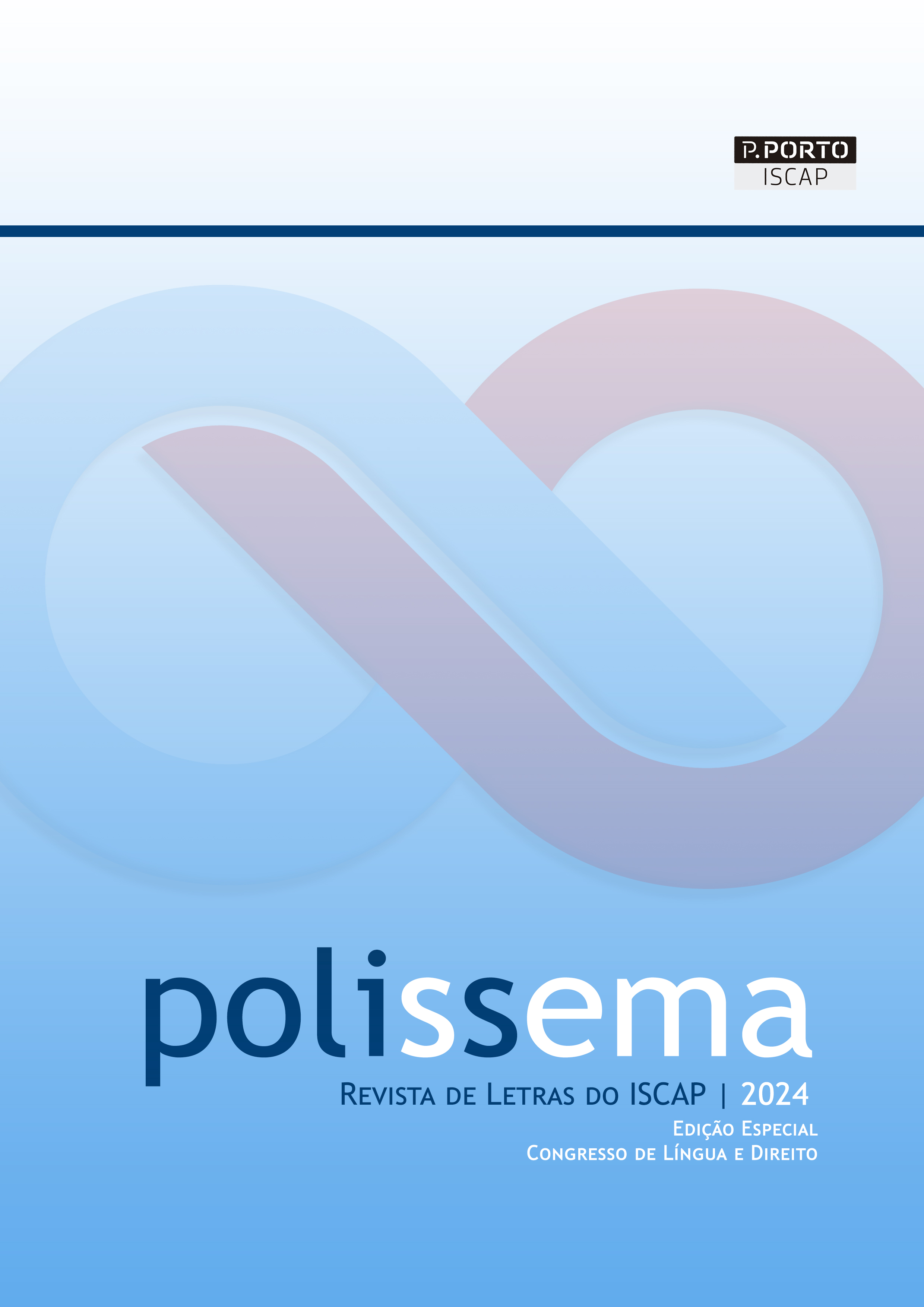PATTERNS OF HUMAN-MACHINE INTERACTION IN LEGAL AND INSTITUTIONAL TRANSLATION: FROM HYPE TO FACT
DOI:
https://doi.org/10.34630/polissema.vi.5750Resumo
Após vários anos de intensas adaptações tecnológicas no sector da tradução, é necessário fazer um balanço das suas implicações, especialmente no que diz respeito à integração da tradução automática (TA) nos fluxos de trabalho. Este artigo apresenta os resultados de um inquérito em larga escala relativo à utilização de inputs gerados por máquinas, nomeadamente através de memórias de tradução (MT) e de sistemas de TA, em várias organizações internacionais. Após algumas considerações sobre a relevância da tradução jurídica em contextos institucionais internacionais, são comparados os padrões de utilização de ferramentas informáticas na tradução de documentos jurídicos, por oposição a outros textos nesses contextos, e a forma como esses padrões variam consoante as organizações ou os perfis dos tradutores. Os resultados revelam um cenário de “tradução aumentada” generalizada, mas com a utilização predominante de MT como ferramentas adequadas para verificar a relevância e a fiabilidade das fontes de traduções anteriores, enquanto as sugestões de pós-edição da TA são integradas aproximadamente em dois terços dos casos, ou ligeiramente menos frequentemente no caso da tradução jurídica. Isto sugere uma abordagem mais cautelosa da interação homem-máquina para a tradução de textos jurídicos, o que também se reflete em variações entre instituições. A tradução “de raiz” limita-se a uma minoria de casos, ao passo que as pontuações por grupos de perfis de acordo com a formação em domínios específicos e com o nível de experiência são muito semelhantes em todas as instituições. A panorâmica fornecida por estes dados serve para desmistificar alguns dos mitos que têm vindo a encorajar o entusiasmo pela TA nos últimos anos.
Referências
Arnejšek, M. & Unk, A. (2020). Multidimensional assessment of the eTranslation output for English–Slovene. In A. Martins et al. (Eds.), Proceedings of the 22nd Annual Conference of the European Association for Machine Translation (pp. 383–392). European Association for Machine Translation.
Directorate-General for Translation, European Commission (2015). DGT Translation Quality Guidelines. European Commission.
Hanzl, J. & Beaven, J. (2017). Quality assurance at the Council of the EU’s Translation Service. In T. Svoboda, Ł. Biel & K. Łoboda (Eds.), Quality Aspects in Institutional Translation (pp. 139–153). Language Science Press. https://doi.org/10.5281/zenodo.1048196.
Killman, J. (2024). Machine Translation in the Legal Context: A Spanish-to-English Comparative Product Study of Statistical vs. Neural MT Output. In M. Winters, S. Deane-Cox, & U. Böser (Eds.), Translation, Interpreting and Technological Change: Innovations in Research, Practice and Training (pp. 136–156). Bloomsbury.
Lommel, A. (2017). How AI Will Augment Human Translation. Common Sense Advisory.
Lommel, A. (2018). Augmented translation: A new approach to combining human and machine capabilities. In C. Cherry & G. Neubig (Eds.), Proceedings of the 13th Conference of the Association for Machine Translation in the Americas (Volume 2: User Track) (pp. 5–12). Association for Machine Translation in the Americas.
Nunes Vieira, L., O’Hagan, M. & O’Sullivan, C. (2021). Understanding the societal impacts of machine translation: a critical review of the literature on medical and legal use cases. Information, Communication & Society, 24(11), 1515–1532. https://doi.org/10.1080/1369118X.2020.1776370.
Pasteur, O. (2013). Technology at the Service of Specialized Translators at International Organizations. In A. Borja Albi & F. Prieto Ramos (Eds.), Legal Translation in Context: Professional Issues and Prospects (pp. 283–297). Peter Lang.
Prieto Ramos, F. (2020a). Translation at International Organizations: The Legal and Linguistic Hierarchies of Multilingualism. In M. Ji & S. Laviosa (Eds.), The Oxford Handbook of Translation and Social Practices (pp. 455–477). Oxford University Press. https://doi.org/10.1093/oxfordhb/9780190067205.013.13.
Prieto Ramos, F. (2020b). The Use of Resources for Legal Terminological Decision-Making: Patterns and Profile Variations Among Institutional Translators. Perspectives, 29(2), 278–310. https://doi.org/10.1080/0907676X.2020.1803376.
Prieto Ramos, F. & Guzmán, D. (2021). Examining institutional translation through a legal lens: A comparative analysis of multilingual text production at international organizations. Target, 33(2), 258–281. https://doi.org/10.1075/target.21003.pri.
Quinci, C. & Pontrandolfo, G. (2023). Testing neural machine translation against different levels of specialisation: An exploratory investigation across legal genres and languages. Trans-kom, 16(1), 174–209.
Roiss, S. (2021). Y las máquinas rompieron a traducir… Consideraciones didácticas en relación con la traducción automática de referencias culturales en el ámbito jurídico. Trans. Revista de Traductología, 25, 491–505. https://doi.org/10.24310/TRANS.2021.v1i25.11978.
Sánchez-Gijón, P. & Kenny, D. (2022). Selecting and Preparing Texts for Machine Translation: Pre-Editing and Writing for a Global Audience. In D. Kenny (Ed.), Machine Translation for Everyone: Empowering Users in the Age of Artificial Intelligence (81–103). Language Science Press. https://doi.org/10.5281/zenodo.6759980.
Stefaniak, K. (2020). Evaluating the usefulness of neural machine translation for the Polish translators in the European Commission. In A. Martins et al. (Eds.), Proceedings of the 22nd Annual Conference of the European Association for Machine Translation (pp. 263–269). European Association for Machine Translation.
Stefaniak, K. (2023). Machine Translation and Terminology: The Experience of the European Commission. In S. Castilho, R. Caro Quintana, M. Stasimioti & V. Sosoni (Eds.), Proceedings of the New Trends in Translation and Technology Conference - NeTTT 2022 (pp. 134–141). INCOMA Ltd. Shoumen.
Strandvik, I. (2020). Digital transformation and institutional translation – change and challenges. In J.-M. Della-Zuanna & C. Kurz (Eds.), Translation Quality in the Era of Digitalization (pp. 466–494). Elanders GmbH.
Tomić, A. & Beltrán Montoliu, A. (2013). Translation at the International Criminal Court. In A. Borja Albi & F. Prieto Ramos (Eds.), Legal Translation in Context: Professional Issues and Prospects (pp. 221–242). Peter Lang.
van der Meer, J. & Joscelyne, A. (2017). Nunc est Tempus: Redesign your Translation Business, Now! TAUS BV.
Vigier Moreno, F. J. & Pérez Macías, L. (2022). Assessing neural machine translation of court documents: A case study on the translation of a Spanish remand order into English. Revista de Llengua i Dret / Journal of Language and Law, 78, 73–91. https://doi.org/10.2436/rld.i78.2022.3691.
Wiesmann, E. (2019). Machine translation in the field of law: A study of the translation of Italian legal texts into German. Comparative Legilinguistics, 37, 117–153. https://doi.org/10.14746/cl.2019.37.4.
Downloads
Publicado
Como Citar
Edição
Secção
Licença
Direitos de Autor (c) 2024 POLISSEMA – Revista de Letras do ISCAP

Este trabalho encontra-se publicado com a Licença Internacional Creative Commons Atribuição-NãoComercial-SemDerivações 4.0.


